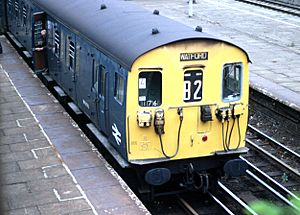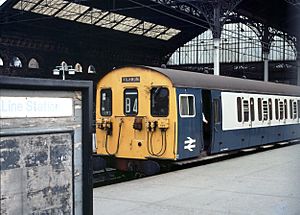British Rail Class 501 facts for kids
Quick facts for kids British Rail Class 501 |
|
|---|---|

A northbound Class 501 train calls at Harrow and Wealdstone. The B2 headcode signifies that this train worked the Broad Street-Watford via Primrose Hill (and vice versa) service.
|
|
| In service | 1957-1985 |
| Manufacturer | British Railways |
| Number built | 57 trainsets |
| Formation | power car + trailer + driving trailer |
| Operator(s) | British Rail |
| Specifications | |
| Car length | 57 ft (17 m) |
| Width | 9 ft 6 in (2.90 m) |
| Height | 12 ft 8 in (3.86 m) |
| Maximum speed | 60 mph (97 km/h) |
| Weight | Total - 106 tonnes |
| Power output | 4 x 185 hp traction motors total 740 hp (552 kW) |
| Electric system(s) | 630 V DC third and fourth rail |
| Track gauge | standard gauge |
The British Rail Class 501 was a special type of train. It was an electric multiple unit, which means it was a train that could run on its own using electricity. These trains were built in 1957 and 1958.
They were made for the busy suburban train lines around London. These lines were once part of the London and North Western Railway and London, Midland and Scottish Railway networks. A total of 57 of these three-car trains were built. They served passengers for many years, helping people travel around the city.
Contents
What is a Class 501 Train?
The Class 501 trains were designed to carry many passengers. Each train was made up of three connected cars. These cars included a power car, a trailer car, and a driving trailer car. This setup allowed the train to be driven from either end.
How They Got Power
These trains got their power from electricity. They used a system called "third and fourth rail." This means there were extra rails on the track. One rail supplied the electricity, and the other helped complete the electrical circuit. This system is common on many London train lines.
Speed and Size
The Class 501 trains could travel at a top speed of about 60 miles per hour (97 km/h). Each car was about 57 feet (17.37 meters) long. The whole train weighed around 106 tonnes. They were built to handle the busy commuter routes efficiently.
Where Did They Run?
The Class 501 trains mainly operated in the London Midland Region. This area covered many suburban lines around London. They were very important for daily commuters.
Main Routes
Some of their main routes included services from Broad Street station to Watford. They also ran between Euston and Watford. Another route was from Broad Street to Richmond. These routes were very busy, especially during rush hour. The trains had special codes, like B1, B2, or B4, to show which route they were on.
End of Service
The Class 501 trains served the public for many years. They were in service from 1957 until 1985. After nearly 30 years, newer trains were introduced. These new trains were more modern and efficient. The Class 501s were then retired from service.



